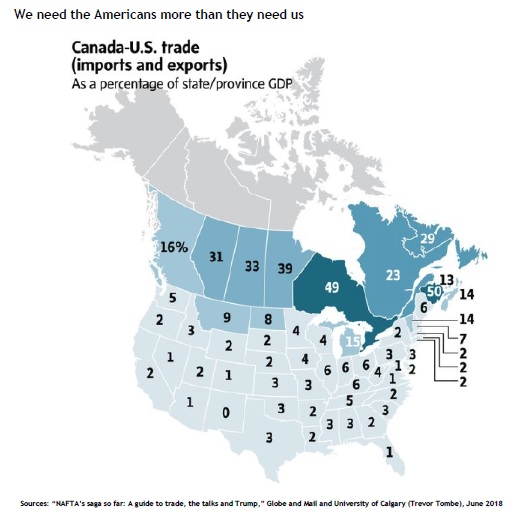NAFTA: is a “bad deal” really worse than no deal for Canada?

Introduction
Notwithstanding the war of words that broke out between the Canadian and U.S. leaders in the aftermath of the G-7 leaders’ summit, we still believe that U.S. President Donald Trump will not seek to shred NAFTA. The political blowback from states (including those that voted for him), businesses and Congress (members from both sides of the aisle) could overwhelm his administration. What’s more, a months-long legal battle would inevitably ensue over whether the President has the authority to formally terminate NAFTA without congressional approval. Going beyond threats would also seriously risk one of Trump’s main talking points: the strong performance of the economy and the financial markets under his watch. The bad news is that the longer negotiations drag on, the riskier investing in Canada and Mexico could become for companies looking for guaranteed access to the U.S. market.
From this perspective, the U.S. tariffs on aluminum and steel imports can be seen as an attempt to create uncertainty in order to extract further trade concessions. “The discussions didn't get far enough to justify another postponement or an exemption,” said Commerce Secretary Wilbur Ross. The threat of tariffs on all imported cars and related parts only add to the pressure.
The strategy behind Trump's tariff tantrums
Business uncertainty created by the prospect of perpetual negotiations combined with seemingly never-ending threats of tariffs could have a greater impact over the longer term than would the actual imposition of protectionist measures. A point Trump has seized upon in the following quote:
“Nobody is moving into Mexico. As long as NAFTA is in flux, no company is going to spend a billion dollars to build an automobile plant. I told the Mexicans we can negotiate forever; as long as we have this negotiation going, nobody is going to build billion dollar automobile plants […]. “We’re getting pretty close to a deal. It could be two weeks, it could be three months, it could be five months; I don’t care.”1
Canada is also feeling the wrath of uncertainty. Indeed, Bombardier is a case in point of how the threat of tariffs can upend business plans. Even though the U.S. International Trade Commission reversed the 300% duty on the C Series, the damage was done. As soon as the duty was imposed, Bombardier entered into an alliance with Airbus that included transferring part of the assembly of the C Series from Canada to the United States in a bid to ward of further tariffs. Despite its legal victory, the alliance is still going ahead with plans to build facilities in the United States as an insurance against potential further protectionist measures.
Conclusion
Given the prospect of never-ending negotiations, we can expect more and more people to challenge Canadian Prime Minister Justin Trudeau’s declaration that a bad deal would be worse than no deal. In their view, a flawed deal should be preferred to the risk of seeing certain companies choosing not to invest in Canada owing to uncertainty over access to the U.S. market. Trump’s musings over whether NAFTA talks should be split into separate negotiations with Mexico and Canada only adds to the uncertainty.
Canada’s difficult position is best summed up in the following quote: “With NAFTA in place, Canada is an option when globally oriented firms considered their North American strategies; without it, Canada is a smallish market that probably can be served from the U.S. or elsewhere.”2 All of this means that the longer the negotiations continue, the weaker Canada’s negotiating position could become.

1 “Trump says he’s in no hurry to finish NAFTA. That’s good because it may take awhile,” Washington Post, April 12, 2018
2 “Canada could pay a steep price for ‘progress’ in NAFTA talks,” Financial Post, January 30, 2018
Source : Economic and Strategy National Bank of Canada

